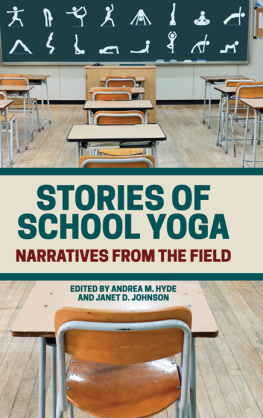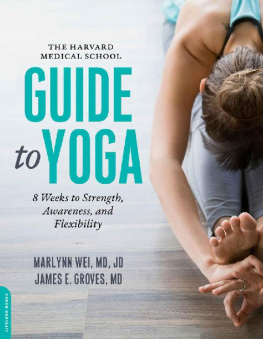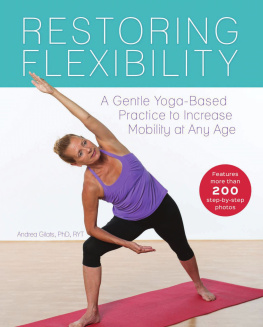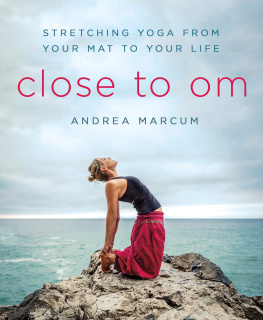Andrea M. Hyde - Stories of School Yoga
Here you can read online Andrea M. Hyde - Stories of School Yoga full text of the book (entire story) in english for free. Download pdf and epub, get meaning, cover and reviews about this ebook. year: 2019, publisher: State University of New York Press, genre: Religion. Description of the work, (preface) as well as reviews are available. Best literature library LitArk.com created for fans of good reading and offers a wide selection of genres:
Romance novel
Science fiction
Adventure
Detective
Science
History
Home and family
Prose
Art
Politics
Computer
Non-fiction
Religion
Business
Children
Humor
Choose a favorite category and find really read worthwhile books. Enjoy immersion in the world of imagination, feel the emotions of the characters or learn something new for yourself, make an fascinating discovery.
- Book:Stories of School Yoga
- Author:
- Publisher:State University of New York Press
- Genre:
- Year:2019
- Rating:5 / 5
- Favourites:Add to favourites
- Your mark:
- 100
- 1
- 2
- 3
- 4
- 5
Stories of School Yoga: summary, description and annotation
We offer to read an annotation, description, summary or preface (depends on what the author of the book "Stories of School Yoga" wrote himself). If you haven't found the necessary information about the book — write in the comments, we will try to find it.
Stories of School Yoga — read online for free the complete book (whole text) full work
Below is the text of the book, divided by pages. System saving the place of the last page read, allows you to conveniently read the book "Stories of School Yoga" online for free, without having to search again every time where you left off. Put a bookmark, and you can go to the page where you finished reading at any time.
Font size:
Interval:
Bookmark:

Stories of School Yoga
Stories of School Yoga
Narratives from the Field
Edited by
Andrea M. Hyde and Janet D. Johnson

Published by State University of New York Press, Albany
2019 State University of New York
All rights reserved
Printed in the United States of America
No part of this book may be used or reproduced in any manner whatsoever without written permission. No part of this book may be stored in a retrieval system or transmitted in any form or by any means including electronic, electrostatic, magnetic tape, mechanical, photocopying, recording, or otherwise without the prior permission in writing of the publisher.
For information, contact State University of New York Press, Albany, NY
www.sunypress.edu
Library of Congress Cataloging-in-Publication Data
Names: Hyde, Andrea M., 1969 editor. | Johnson, Janet D., 1968 editor.
Title: Stories of school yoga : narratives from the field / edited by Andrea M.Hyde and Janet D. Johnson.
Description: Albany : State University of New York Press, [2019] | Includes bibliographical references and index.
Identifiers: LCCN 2018043672 | ISBN 9781438475691 (hardcover : alk. paper) | ISBN 9781438475707 (pbk. : alk. paper) | ISBN 9781438475714 (ebook)
Subjects: LCSH: Affective education. | Hatha yoga for childrenStudy and teaching. | Hatha yoga for teenagersStudy and teaching. | School childrenMental health.
Classification: LCC LB1072 .S86 2019 | DDC 370.15/34dc23
LC record available at https://lccn.loc.gov/2018043672
10 9 8 7 6 5 4 3 2 1
Contents
Introduction
I Just Breathe: Stories of School Yoga
Janet D. Johnson and Andrea M. Hyde
Chapter 1
Qualitative Research and School Yoga
Andrea M. Hyde and Janet D. Johnson
Chapter 2
The World Is Made Up of Stories
Janet D. Johnson and Andrea M. Hyde
Chapter 3
One School, Calm and Alert
Helene McGlauflin
Chapter 4
S.T.O.P. and Relax: A Yoga Curriculum for Students with Autism
Debra A. Krodman-Collins
Chapter 5
Achieving and Breathing: the Yoga Journey of a Public School Teacher
Lindsay Meeker
Chapter 6
Empowering Schools from the Inside: Training Leaders for Sustainable Yoga
Lisa Flynn
Chapter 7
SEL, Yoga, and Mindfulness: Developing Teacher Competencies
Carla Tantillo Philibert with Peggy C. Collings
Chapter 8
Creating a Nonviolent World: The CALMING KIDS Story
Dee Marie
Chapter 9
Sharing the Practices with Urban Elementary Students
Michelle Brook
Chapter 10
Yoga for Health and Physical Education (and More)
Joanne Spence
Chapter 11
Practicing Yoga, Practicing Justice
Peg Oliveira
Conclusion
A Place for Making Meaning
Andrea M. Hyde and Janet D. Johnson
Acknowledgments
We wish to acknowledge the inspiration, guidance, and encouragement of those whose support was necessary for this project to come into existence. The motivation for this book came from the stories and experiences of yoga service providers and yoga teachers who bring yoga to schools every day.
We are indebted to Edi Pasalis and Iona Smith and the other organizers of the Yoga in Schools Symposium and Research Summit at the Kripalu Center for Yoga and Health, where we first met in 2015. We especially thank Sat Bir Khalsa, Catherine Cook-Cottone, and Tamar Mendelsohn for their continuing support for research on yoga in schools. We also acknowledge and thank Michelle Kelsey Mitchell and the other organizers of the National Kids Yoga Conference for providing a continuing community for us all.
The authors in this volume embraced the opportunity to share their stories with us and with the school yoga community. Their narratives are modest snippets from the important work they do, and we are grateful for their contributions to the field and to this volume. Their tireless and joyful advocacy for students and teachers through yoga is inspiring.
We received personal and professional support from our colleagues and institutionsWestern Illinois University and Rhode Island College. Janet received a faculty research grant from RIC that allowed her to travel to work with Andrea in the Quad Cities. We are also grateful to QualRIC, a qualitative research group that provided extensive feedback on early drafts of the book proposal and beginning chapters.
We thank the reviewers who provided comprehensive and valuable feedback. Their words pushed us to do be more precise and aware of what was missing. We also thank SUNY editor Rebecca Colesworthy, who provided expert suggestions on revision and encouraged us to make this book into readable scholarship for multiple audiences.
We thank our families, particularly our husbands, who endured many evenings and weekends by themselves as we worked on this book together and alone. As readers, writers, and partners, their love and support was incredibly important. Thanks also to our fur-babies, Andy, Bailey, Mama Cass, Ozzy, and Silent Bob, who kept us company and, more importantly, reminded us to punctuate our sedentary work with snuggles, snacks, naps, and play.
And finally, we thank each other for friendship, collegiality, and hard-nosed scholarship. We pushed each other to extend our learning and examine our assumptions about yoga, research, theory, and social justice. We are better writers and researchers as a result of this partnership.
Introduction
I Just Breathe: Stories of School Yoga
J ANET D. J OHNSON AND A NDREA M. H YDE
Yoga is a process of replacing old patterns with new and more appropriate patterns.
Sri T. Krishnamacharya
When Im really mad and like ready to explode, I just breathe. And every time I breathe out I just let all the anger out.
William, yoga student
High school youth trail into the basement classroom at 9 a.m., yawning as they tease each other or look at their phones. William sweeps one half of the classroom where chairs and tables have been pushed aside. The classroom teachers direct students to the free breakfast of packaged muffins and orange juice, and then to the computers lined up against the wall, where students log in to their individual plans. When Janine, the yoga teacher, arrives, bike helmet still on, the hum in the room gets louder. Students jostle each other as they move to unfurl their yoga mats into an uneven circle. Miss, can I ring the chime? Miguel asks. Janine hands him the chime, and class begins. When students are lying on their backs for the final resting pose 50 minutes later, the room is quiet and still until the morning announcements blast suddenly from the ceiling speakers, interrupting the peace. David, eyes still closed, gives an obscene salute to the disembodied voice.
This kind of scene (with or without the salute) occurs in hundreds of K-12 schools across the United States. The yoga-in-schools movement, along with the mindfulness in education movement, has gained momentum over the past several years as adult practitioners realize the benefits of yoga in their personal lives and want children and youth to have the same opportunity to experience them.
Because yoga attends to both mind and body, it supports student overall well-being, which has led to its use in schools across the country. Teachers use yoga-based mindfulness techniques to provide mental breaks and physical activity during instruction and as part of their classroom management approach to help students become more aware of their emotions and actions and, in turn, to self-regulate their behavior. ESL teachers show their students how yoga poses are universal across diverse languages. Counselors teach mindfulness practices to support self-calming and stress reduction for students with behavioral issues. Schools adopt yoga and mindfulness to enhance social emotional learning (SEL), health and physical education, and anti-bullying programs. Educators also use yoga-based mindfulness practices to support principles of inclusive classrooms as well as academic content standards for second language acquisition, development standards for Early Childhood, and universal ethics. Mindfulness and yoga also appear in higher education, as yogi-academics, including teacher educators like ourselves, use the practices in their classrooms to support learning and well-being.
Font size:
Interval:
Bookmark:
Similar books «Stories of School Yoga»
Look at similar books to Stories of School Yoga. We have selected literature similar in name and meaning in the hope of providing readers with more options to find new, interesting, not yet read works.
Discussion, reviews of the book Stories of School Yoga and just readers' own opinions. Leave your comments, write what you think about the work, its meaning or the main characters. Specify what exactly you liked and what you didn't like, and why you think so.











